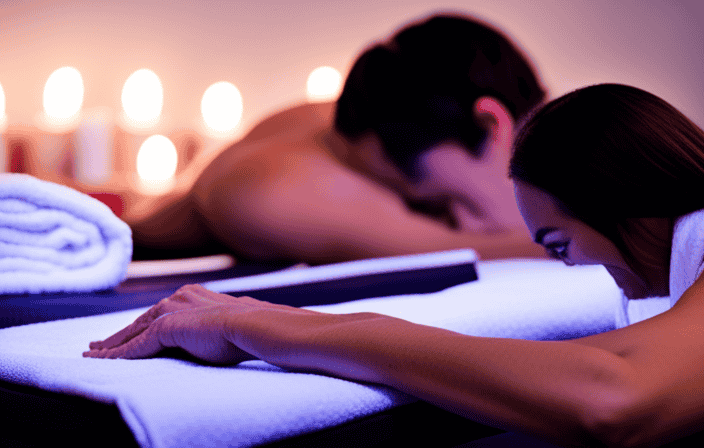Massage therapy provides numerous advantages for relaxation, stress reduction, and overall health. It can ease muscle tension, headaches, and discomfort, as well as decrease stress-related mood swings and enhance the quality of sleep.
With various techniques such as dim lighting, gentle pressure, and aromatic scents, massage therapy creates a soothing environment. Whether you prefer Swedish, hot stone, or reflexology massage, each type caters to individual preferences and needs.
By promoting relaxation, improving blood circulation, and impacting the nervous system, massage therapy plays a vital role in enhancing overall rejuvenation and self-care.
Prioritizing stress relief is crucial for maintaining optimal physical and mental health, and seeking professional massage therapy can be a valuable step towards achieving that balance.
Key Takeaways
- Massage therapy provides relaxation and stress relief by relieving muscle tightness, headaches, and pain.
- Massage therapy promotes overall well-being by improving physical and mental health, reducing stress-induced mood changes, and easing insomnia caused by stress.
- Different massage techniques, such as shiatsu, chair massage, and aromatherapy massage, offer specific benefits for relaxation and stress relief.
- Massage therapy has a positive impact on the nervous system by producing natural hormones, promoting sleep, stimulating the production of melatonin, and enhancing blood circulation and skin health.
The Benefits of Massage Therapy: Relaxation, Stress Relief, and Overall Well-being
I find that massage therapy provides incredible benefits for relaxation, stress relief, and overall well-being.
When I receive a massage, I feel a sense of calm and tranquility wash over me. The dim lighting and soothing atmosphere create the perfect environment for relaxation. As the therapist kneads my joints and muscles with slow pressure, I can feel the tension melt away. The techniques used, such as Shiatsu massage and aromatherapy, further enhance the experience, reducing stress, tension, and pain.
Not only does a massage provide much-needed ‘me time’ for self-care, but it also improves my physical and mental health. The release of natural hormones, like serotonin and melatonin, during a massage promotes better sleep and mood regulation. Additionally, the improvement in blood circulation and skin health leaves me feeling rejuvenated.
Overall, massage therapy is a vital tool in promoting relaxation, stress relief, and overall well-being.
Importance of Stress Relief
Stress can lead to muscle tightness, headaches, and pain, making it crucial to find effective methods for relief. One such method is massage therapy, which offers numerous benefits for stress relief and overall well-being.
Massage not only helps to alleviate physical tension but also reduces stress-induced chemicals that can cause mood changes. It can also ease insomnia caused by stress, allowing for better sleep and rejuvenation.
Moreover, massage provides valuable ‘me time’ for self-care, allowing individuals to prioritize their wellness and relaxation.
By promoting relaxation and relieving stress, massage therapy plays a vital role in improving both physical and mental health. With its ability to reduce muscle tightness, headaches, and pain, massage therapy offers a holistic approach to stress relief and overall well-being.
Promoting Relaxation
Promoting relaxation is essential for achieving a state of calm and tranquility. Through the use of various massage techniques, individuals can find relief from stress, tension, and pain. Aromatherapy massage, for example, transports the mind to relaxing places, while shiatsu massage targets specific pressure points to reduce stress and promote relaxation.
To further illustrate the benefits of massage therapy in promoting relaxation, consider the following table:
| Massage Technique | Benefits |
|---|---|
| Aromatherapy | Transports the mind to relaxing places |
| Shiatsu | Reduces stress and tension |
| Swedish | Offers a gentle and soothing experience |
| Hot stone | Provides a comforting sensation |
By incorporating these techniques into a massage session, individuals can experience a deep sense of relaxation and rejuvenation. Massage not only helps to relieve muscle tightness and pain but also stimulates the production of natural hormones that improve mood and reduce stress. It promotes better sleep through the release of serotonin and melatonin, enhancing overall well-being. So, if you’re looking to find relaxation, stress relief, and a renewed sense of well-being, consider incorporating massage therapy into your self-care routine.
Different Massage Techniques
Swedish massage offers a gentle and soothing experience, allowing for a deep sense of relaxation and rejuvenation. This popular massage technique involves long, gliding strokes, kneading, and circular movements to target the muscles and promote relaxation.
The therapist applies light to medium pressure, focusing on relieving tension and improving blood circulation. Swedish massage is known to reduce stress, ease muscle tightness, and enhance overall well-being. It can also help to alleviate pain, improve flexibility, and promote a sense of calmness.
This technique is particularly beneficial for those who prefer a softer touch and want to unwind and de-stress. With its gentle yet effective approach, Swedish massage is a wonderful choice for anyone seeking a tranquil and rejuvenating experience.
Impact on Overall Well-being
I feel a sense of rejuvenation and improved mood after a massage. The impact of massage on overall well-being is truly remarkable. During a massage, natural hormones are released, such as serotonin, which helps to elevate mood and reduce pain. This release of serotonin also promotes better sleep, allowing for improved rest and relaxation.
Additionally, massage stimulates the production of melatonin, another hormone that plays a crucial role in regulating sleep patterns.
Not only does massage have a positive impact on the hormonal system, but it also enhances overall rejuvenation of the body. By improving blood circulation, massage helps to deliver oxygen and nutrients to the muscles and organs, promoting their optimal functioning. Furthermore, regular massage can contribute to improved skin health, as it increases blood flow to the skin, promoting collagen generation and a youthful appearance.
In conclusion, the benefits of massage therapy on overall well-being are undeniable. From improved mood and sleep to enhanced circulation and skin health, massage provides a holistic approach to self-care and wellness.
Holistic Benefits
Now that we have discussed the impact of massage on overall well-being, let’s delve into the holistic benefits it offers.
Massage therapy goes beyond just addressing physical discomfort; it nurtures the mind, body, and soul. As someone who has experienced the transformative power of massage, I can confidently say that it works with your inner self, allowing you to tap into a sense of deep relaxation and connection.
Here are five holistic benefits you can expect from regular massage sessions:
- Deepens the mind-body connection, promoting a sense of harmony
- Releases stagnant energy and promotes emotional release
- Enhances self-awareness and mindfulness
- Boosts overall energy levels and vitality
- Nurtures a sense of well-being and inner peace
By incorporating massage therapy into your self-care routine, you can experience these holistic benefits and cultivate a more balanced and fulfilling life.
Finding the Best Massage Therapy
When searching for the best massage therapy, it’s important to consider factors such as location, skilled therapists, and a prioritization of wellness and self-care.
At Miraclerehabclinic.com/city/northville, we offer a free consultation to assess your needs and provide personalized treatment. Our skilled therapists are trained in various techniques to provide effective massages tailored to your specific requirements.
With a convenient location near your area, you can easily access our services and prioritize your well-being. We understand the importance of wellness and self-care, which is why we are dedicated to delivering exceptional massage therapy that promotes relaxation, stress relief, and overall well-being.
Trust us to provide a soothing environment and professional care that will leave you feeling rejuvenated and refreshed. Book an appointment today and experience the benefits of our top-notch massage therapy.
Impact on the Nervous System
Massage therapy has a positive impact on the nervous system by producing natural hormones that adjust mood and reduce pain. Serotonin, a hormone that contributes to feelings of well-being and happiness, is released during a massage, promoting better sleep and relaxation. Additionally, the production of melatonin is stimulated, which helps regulate sleep patterns. These hormonal changes contribute to the overall rejuvenation of the body and enhance mental and physical well-being.
Massage therapy also improves blood circulation, allowing for better nutrient and oxygen delivery to the tissues. This, in turn, promotes collagen generation, leading to healthier skin. The relaxation induced by massage helps reduce stress and tension, allowing the nervous system to relax and function more efficiently.
To further illustrate the benefits of massage therapy on the nervous system, here is a comparison table:
| Massage Therapy Benefits | Impact on Nervous System |
|---|---|
| Adjusts mood | Produces natural hormones |
| Reduces pain | Serotonin release |
| Promotes better sleep | Stimulates melatonin |
Incorporating regular massage therapy into your wellness routine can greatly improve your overall well-being and promote a healthier, more balanced nervous system.
Techniques for a Relaxing Massage
I find that dim lighting creates a more soothing atmosphere for a relaxing massage. When the lights are dimmed, it helps to create a sense of calm and tranquility. It allows me to fully relax and let go of any tension or stress I may be feeling.
Additionally, the low lighting helps to reduce visual distractions, allowing me to focus on the sensation of the massage and fully enjoy the experience.
To further enhance the relaxation during a massage, there are a few techniques that I find particularly effective:
-
Kneading joints and muscles with slow pressure: This technique helps to release tension and promote relaxation in the targeted areas. The slow, rhythmic movements allow for deeper penetration and a more profound sense of relief.
-
Shiatsu massage: This technique involves applying pressure to specific points on the body to reduce stress, tension, and pain. It is particularly effective in promoting relaxation and restoring balance to the body.
-
Aromatherapy massage: By incorporating essential oils into the massage, it adds an extra layer of relaxation. The scents of the oils can transport the mind to a peaceful and calming place, enhancing the overall experience.
By utilizing these techniques and creating a soothing atmosphere with dim lighting, a massage can become a truly rejuvenating and relaxing experience.
Different Types of Massage
Among the different types of massage, Swedish massage offers a gentle experience that promotes relaxation and stress reduction. This popular technique involves using long, flowing strokes and kneading to release muscle tension and improve circulation. The soothing motions of Swedish massage help to calm the nervous system and induce a state of deep relaxation. It is particularly effective in alleviating stress, anxiety, and muscle soreness.
To provide a deeper understanding of the different types of massage, here is a table summarizing their key features:
| Massage Type | Description | Benefits |
|---|---|---|
| Swedish | Gentle strokes and kneading | Promotes relaxation and stress reduction |
| Hot Stone | Uses heated stones to relax muscles | Relieves muscle tension and promotes relaxation |
| Japanese | Focuses on emotional and physical calm | Enhances overall well-being and promotes relaxation |
| Reflexology | Targets specific points on the feet, hands, and head | Relieves tension and improves overall well-being |
Each type of massage offers its own unique benefits, catering to different needs and preferences. Whether you are seeking relaxation, stress relief, or overall well-being, there is a massage technique that can provide the desired results.
Massage’s Effect on Blood Circulation
Now that we have explored the different types of massage, let’s delve into the fascinating effects of massage on blood circulation.
One of the key benefits of massage therapy is its ability to improve blood circulation throughout the body. As the massage therapist applies pressure and kneads the muscles, it helps to stimulate the blood vessels, allowing for better blood flow.
This increased circulation delivers oxygen and nutrients to the muscles and tissues, promoting their health and healing. Additionally, improved blood circulation helps to remove waste products and toxins from the body, aiding in detoxification.
The enhanced blood flow also promotes collagen generation, which is essential for maintaining healthy skin. So, the next time you indulge in a relaxing massage, know that it not only provides stress relief but also plays a vital role in optimizing your overall well-being.
Frequently Asked Questions
How often should I get a massage for optimal relaxation and stress relief?
For optimal relaxation and stress relief, I recommend getting a massage on a regular basis. Depending on your individual needs and preferences, this could be once a week, bi-weekly, or monthly. It’s important to listen to your body and schedule massages accordingly.
Can massage therapy help with specific conditions such as chronic pain or anxiety?
Massage therapy can be a valuable tool in managing chronic pain and anxiety. Through targeted techniques and the release of natural hormones, it helps alleviate symptoms and promotes a sense of calm and well-being.
Are there any potential risks or side effects associated with massage therapy?
Yes, there are potential risks and side effects associated with massage therapy. These may include temporary discomfort, bruising, soreness, allergic reactions to oils or lotions, and rare cases of nerve or muscle injury. It’s important to consult with a qualified therapist and disclose any medical conditions or concerns before receiving a massage.
How long does the relaxation and stress relief benefits of a massage typically last?
The relaxation and stress relief benefits of a massage typically last for a few hours to a few days. However, the duration can vary depending on individual factors such as stress levels, lifestyle, and ongoing self-care practices.
Is it necessary to undress completely during a massage session?
During a massage session, it is not necessary to undress completely. Your comfort is a priority, and therapists can adapt their techniques to work with clothing on, ensuring a relaxing and effective experience.
Conclusion
In conclusion, massage therapy is a valuable tool for promoting relaxation, relieving stress, and improving overall well-being. It offers a range of benefits, including muscle tension relief, headache and pain reduction, and improved sleep.
By working with the nervous system, massage therapy stimulates the release of hormones that adjust mood and reduce pain, leading to a sense of rejuvenation. Different techniques and types of massage cater to individual preferences and needs, creating a personalized and relaxing experience.
Prioritizing stress relief through massage therapy is essential for maintaining optimal physical and mental health. So why not treat yourself to some well-deserved self-care and book an appointment today?









